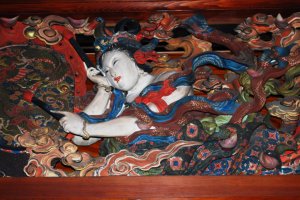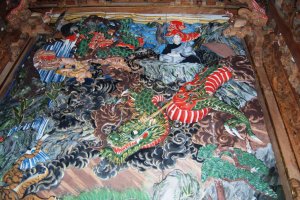“Michelangelo of Echigo” he is called, yet the bearer of this name is neither Italian nor is Echigo a province of Italy. His real name is Ishikawa Uncho (1814-1883) and he lived in Japan 300 years after the Italian maestro. What the two men had in common is their artistic genius.
Ishikawa was, like the Italian primo, an outstanding sculptor and painter. His specialty was wood carvings and his brilliant works brought him the status of a local celebrity.
Born in Edo (now Tokyo) the Japanese Michelangelo stayed for thirteen years at Eirinji Temple, a 500-year old zen temple in the province of Echigo, now part of Niigata Prefecture.
Legend tells us that he came to Eirinji on the condition that he was given “good sake and chisels for life”, a seemingly unusual deal for a temple.
Ishikawa was known to like sake and gambling, unlike the real Michelangelo who lived a rather abstinent life. Ishikawa also liked the local beauties and some of them might have become models for his sculptures. The temple’s frescos show vivid expressions of some girls who play instruments and look anything but otherworldly.
It seems that he was quite a character for his time and it turns out that Eirinji Temple is locally known as the “gambling temple”, making the master carver and his benefactors a perfect fit. Despite, or because of, his eccentric life, he created a great number of fantastic wood carvings.
Ishikawa’s masterpiece, however, is a carved ceiling at another temple. Like Michelangelo’s painted ceiling of the Sistine Chapel in Rome, Ichikawa’s carved ceiling at Saifukuji Temple is sheer brilliance.
Saifukuji is a Soto Zen Buddhist temple and a pilgrimage destination of followers of this school of Buddhism.
The Ishikawa ceiling, commissioned by the temple’s priest at the time and completed in 1867, is in the temple’s main hall, the Kaisando. The hall serves to perform memorial rites in honor of the various priests of this temple and of the first Soto Zen master of Japan, Dogen-zenji.
The carving depicts the story of Dogen-zenji who encountered an aggressive tiger while walking in China where he went to further his Buddhist education. According to legend his walking stick transformed into a dragon, said to be his guardian animal, which saved the priest from the claws of the tiger.
A massive fire-spewing dragon is chasing the tiger through the woods and across a river and literally off the ceiling. This carving is painted colorfully whereas the wooden lintels and the plaster work which extend the artwork from the ceiling onto the walls were left unpainted. Starring up the ceiling, visitors get lost in the exquisite details of this work trying to “carve” it into their memory as photography is usually forbidden.
Ishikawa spent six years on all the carvings and decoration for this temple while Michelangelo took only four years for painting the ceiling of the Sistine Chapel.
There are many other temples in the local area that hold works by Ishikawa Uncho. Honjoji Temple in Sanjo City is one of them.
The head temple of the Hokke Sect of Nichiren Buddhism was originally built in 1297 by a priest named Nichiin Shonin. According to legend, the priest walked around with a holy white cow as he spread the teachings of Nichiren, the Lotus Sutra school of Buddhism. A statue of a white wooden cow is now sacred to this temple.
Next to the “holy cow” sits the wood carving of another cow, holy or not we don’t know, which was made by Ichikawa. This temple too is home to several of his wood carvings, mainly animals, and wood panels.
The maestro also found his final resting place here and his gravestone can be found behind the main temple hall.
Practical information:
- Eirinji Temple: 9:00 to 16:00 year-round; yen 300 adult fee
- Saifukuji Temple: 9:00 to 16:00 year-round; yen 300 adult fee
































